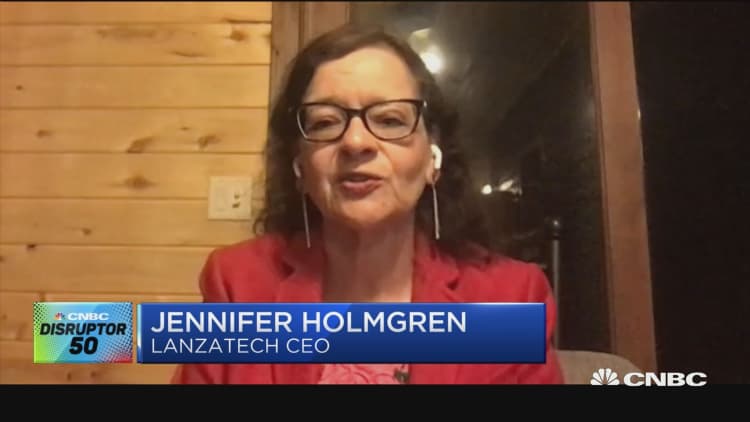Jet fuel is a notorious bugaboo in the race to lower emissions.
Chicago-based start-up LanzaJet is trying to address the problem by producing an alternative to petroleum-based conventional jet fuel that has lower carbon emissions and works with existing airline industry infrastructure.
The company, formed in 2020, hasn't generated any revenue yet, but it's gotten plenty of funding to get going. It recently received $50 million in funding from Microsoft, adding to previous investments from Shell and a handful of other energy companies and airlines, and the U.S. Department of Energy has invested $14 million in a subsidiary of the company to build LanzaJet's first plant in Georgia. By 2023, that plant is expected to be producing tens of millions of gallons of sustainable jet and diesel fuels.
Nonmilitary aviation represents 11% of United States transportation-related emissions, according to The White House. And almost all of those emissions come from jet fuel, says Dan Rutherford, the aviation director at the International Council on Clean Transportation. For example, United reported 15.49 million metric tons of carbon dioxide equivalent in 2020, and 15.39 million metric tons of that came from jet fuel.
No new planes or new plane engines required
There are several ways to decarbonize the airline industry, which is generally considered one of the hardest sectors to make clean.
None of them are perfect.
Electric planes are in their early stages of development and production, but current battery technology has range limitations, and the batteries themselves are heavy, which is a problem in air travel.
Hydrogen-powered planes are another possibility, but producing clean hydrogen today is expensive, and it wouldn't work on existing planes. Engines would have to be modified. Airbus is developing a hydrogen-powered plane, for instance, but it may not be in production until 2035.
Compatibility with existing planes is necessary to start cleaning up the airline industry today, as airplanes last for between 20 and 30 years and designing a new aircraft takes about a decade.
Also, aviation is necessarily a global industry. A solution has to work everywhere a plane goes.
"So, the U.S. may make progress in developing and deploying a hydrogen-powered aircraft. Will India also be ready to accept and refuel that aircraft?" said LanzaJet CEO Jimmy Samartzis.
That leaves sustainable aviation fuel, or SAF, which is certified to work with existing planes. LanzaJet's SAF can be blended with regular jet fuel in a 50/50 mix.
"For us, it's about the urgency of needing to take action today." Samartzis told CNBC. "SAF is the best solution for the coming years and likely two-plus decades."
LanzaJet's technology is able to use any ethanol, which is made from plant material. But not all ethanol is created with the same climate footprint.
In the United States, 94% of ethanol is produced from corn, according to the Department of Energy's Alternative Fuels Data Center.
But jet fuel produced from corn ethanol in the U.S. would have emissions similar to regular jet fuel, once you factor in all the carbon dioxide emitted in producing that corn, according to one analysis from the International Council on Clean Transportation. Samartzis points to an analysis from the Environmental Protection Agency estimating that SAF produced from today's corn ethanol has only 15% lower "carbon intensity" than petroleum jet fuel, but Rutherford says that analysis is "optimistic." The EPA also charts a pathway through which corn ethanol could be produced with 153% lower carbon intensity than conventional jet fuel, if every clean innovation is implemented, a process that Rutherford calls "speculative" at best.
LanzaJet is committed to using ethanol that was created with minimal carbon emissions.
For the plant in Soperton, Georgia, LanzaJet will use ethanol made from low-carbon-intensity sugarcane; corn crop residues including corn kernel fiber and corn stover; biogas; and waste gas from industrial processes.
The biogas and waste gas processes were pioneered by sister company LanzaTech (one of CNBC's Disruptor 50 companies). LanzaTech uses a bacteria fermentation process to convert pollution into fuels and chemicals, in a process similar to making beer.

In the future, LanzaJet may consider using ethanol made from corn if it can be made with low carbon intensity, either through carbon capture and sequestration or other methods.
"There's work to do in the corn ethanol industry to improve the carbon intensity of corn ethanol and to create a better understanding of the actual performance of a lower carbon intensity of corn ethanol than what is reported as a blanket statistic for the industry," Samartzis told CNBC. "Some corn ethanol producers have done good work in lowering the carbon intensity of their corn ethanol."
Samartzis came to the start-up from United, where he worked for more than a decade to develop the sustainable aviation industry. The ethos in the space has changed, he says.
At United, around 2008, alternative fuel investigations were catalyzed by sky-high crude oil prices. Now, however, the industry momentum is fueled by efforts to mitigate the effects of climate change.
"I think the pressure to take action is certainly there today. It wasn't there 13 years ago," Samartzis said. "That pressure comes from investors, it comes from consumers. And it comes from governments, frankly, who are tightening things up and saying you have to do better."
In September, the Biden administration said it was taking steps to decarbonize the airline sector by 2050, and SAF will be a key part of that.
"In the future, electric and hydrogen-powered aviation may unlock affordable and convenient local and regional travel," the Biden administration said. "But for today's long-distance travel, we need bold partnerships to spur the deployment of billions of gallons of sustainable aviation fuels quickly."
Racing to market
LanzaTech's early work has enabled LanzaJet to move quickly, said Samartzis.
"The science is hard, and it takes a long time for companies to develop new technology. In our case, scale-up has taken nearly 10 years," Samartzis told CNBC.
For Shell, LanzaJet's technology will help it meet its goal to produce around 2 million tonnes of SAF a year by 2025, a company spokesperson told CNBC. Shell aims to have 10% of its global aviation fuel sales be SAF by 2030. To get there, Shell will sublicense the LanzaJet technology in coming years.
Microsoft's $50 million investment in LanzaJet is part of its Climate Innovation Fund, through which the software behemoth is investing $1 billion over four years to develop technologies that reduce its own carbon footprint and those of its suppliers and customers.
Microsoft will also get access to renewable diesel made by LanzaJet, which it can use to power backup generators at its data centers.
Jet fuel is certainly the focus of LanzaJet, but it's possible for LanzaJet to use its same plant to produce renewable diesel, Samartzis says.
The main trick for LanzaJet now is to make its SAF product affordable.
"Sustainable aviation fuel products historically that have been, 3x 4x 5x 6x the price of conventional fossil based jet fuel," Samartzis said. "We're trying to build a new industry. And we're trying to give it momentum. And part of the way that we do that is by saying, our product is not 3x."



